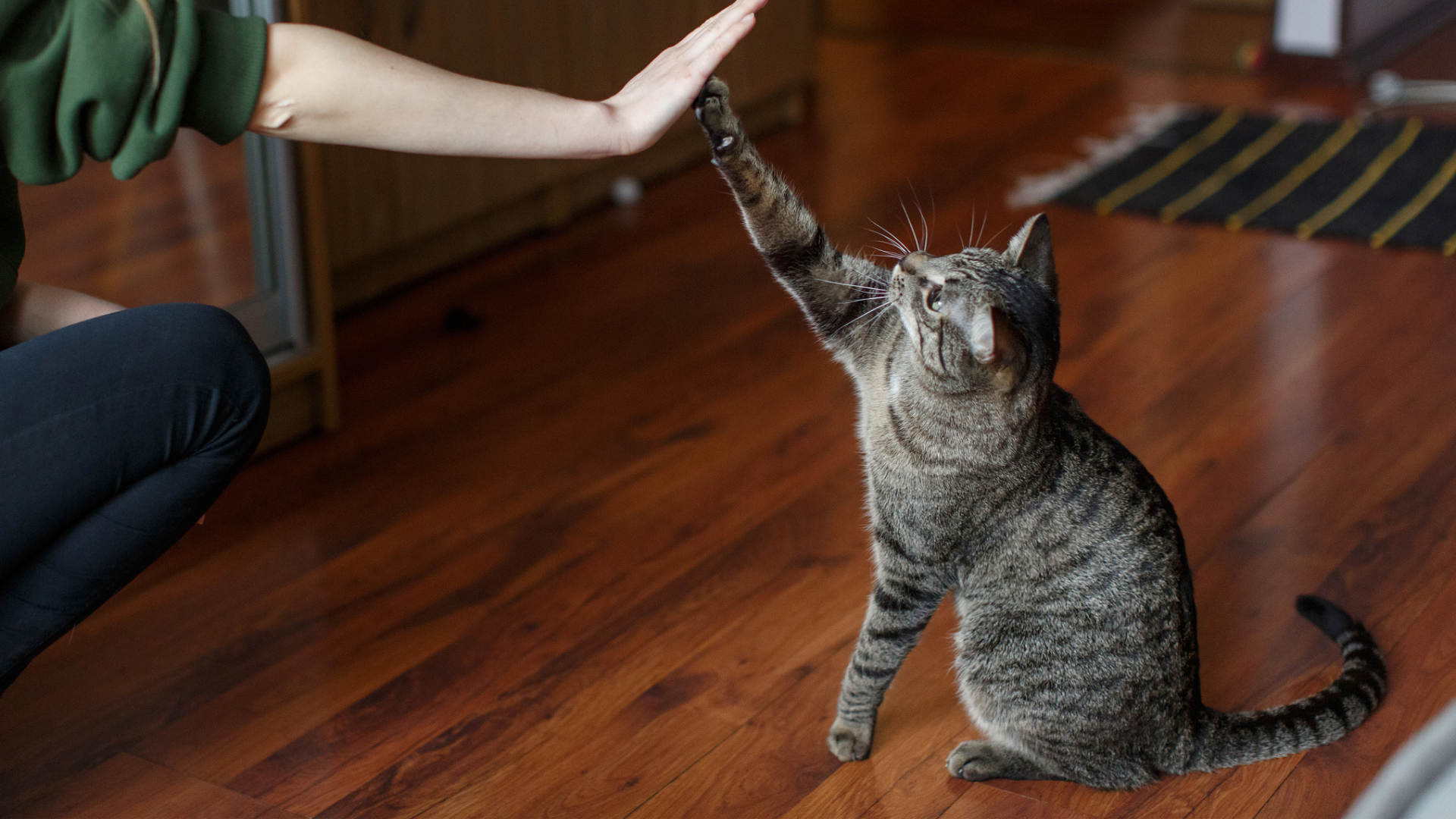Expert reveals how to teach a cat a trick (we can’t believe how simple it is!)
Want to learn how to teach a cat a trick? Here are three easy ones to try at home

Have you ever wondered how to teach a cat a trick? Or questioned if it’s even possible? Whilst we might associate tricks with our canine companions, it’s something that our cats can get involved with too — and it’s easier than you might think!
There are lots of reasons why you might want to teach your cat a trick. Not only is it great for mental stimulation when they’re not playing with the best cat toys, but it also helps to strengthen your bond with them. Plus, there’s no denying that it's a pretty cool party trick.
This might come as a surprise but cats can learn a variety of commands. From ‘sit’ to ‘high five’, there’s lots of things you can teach them. So, how do you do that exactly? It all comes down to positive reinforcement, so you’ll want to have some tasty treats or the best interactive cat toys to hand.
We asked expert vet Dr. Bethany Hsia for her top tips on teaching tricks and how long it takes to train them. She’s also given instructions on how to teach basic commands like ‘sit’, ‘high five’ and ‘roll over’, and explained the benefits of doing so. Here’s what you need to know:
Can you teach a cat a trick?
Questioning, 'Can you train a cat?' The answer is yes — and it's simpler than it sounds. Dr Hsia says that teaching tricks takes just four things: using positive reinforcement methods, having patience, keeping sessions short and staying consistent.
She explains: "It is indeed possible to teach a cat a trick. Whilst cats are known for their independent nature, they can be trained using positive reinforcement techniques. Cats are intelligent animals and can learn various tricks with patience, consistency, and the right approach."
Positive reinforcement is when you reward the desired behavior. This can be done by giving them the best cat treats, praise or play.
Get the best advice, tips and top tech for your beloved Pets
Frisco Fabric Teaser Wand Cat Toy
Your search is over for the best cat toy. This teaser wand is affordable, durable and our tester's cats loved chasing it around. Not only does it help to keep your cat mentally and physically stimulated, but it makes a great reward after teaching them a trick.
Dr. Hsia notes that cats don't have very good attention spans. That's why it's a good idea to keep sessions brief and frequent. She also explains that by keeping your commands and rewards consistent, your cat will understand what you expect from them.
So, how long does it take to teach a cat a trick?
She says: "The speed at which a cat learns a trick can vary depending on the individual cat, the complexity of the trick, and the training methods used. Some cats may pick up simple tricks like sitting or high-fiving within a few days to weeks, while more complex tricks may take longer."

Why should I teach my cat tricks?
Aside from being entertaining to watch, it turns out that teaching tricks has benefits for your cat too:
1. It provides mental stimulation
Is your cat bored? If they are, then they might be lacking mental stimulation. From why do cats suck on blankets to why do cats eat hair, there are all sorts of behaviors cats choose to engage in that are often the result of boredom. To help prevent this, experts recommend playing with your cat for 15 to 20 minutes, two to three times a day, and teaching them a trick can be included in this.
2. It strengthens your bond
If you want to improve the relationship with your cat, teaching them a trick is a good way about it. Not only does it help to build trust and communication, but they'll also associate you with fun and rewards.
3. It provides physical stimulation
To avoid health problems like obesity, it's important that your cat stays active and gets enough physical stimulation. This might be harder for indoor cats, so it's worth stocking up on the best toys for indoor cats.

How to teach a cat to sit
Difficulty level: Easy
You will need: Cat treats and a quiet training area
Instructions:
1. "Hold a treat close to your cat’s nose.
2. Slowly move your hand with the treat upwards, causing your cat to follow it with their head.
3. As your cat raises its head, its bottom will naturally lower into a sitting position.
4. Once your cat sits down, say 'sit' and give them the treat.
5. Repeat this process several times during short training sessions."

How to teach a cat to high five
Difficulty level: Moderate
You will need: Cat treats and patience
Instructions:
1. "Hold a treat in one hand and show it to your cat.
2. Raise your hand slightly above their head so they reach up with their paw.
3. As they raise their paw towards your hand, say 'high five'.
4. When their paw touches your hand (or even if they make an attempt), reward them with the treat.
5. Practice this regularly until your cat associates raising their paw with getting a treat."

How to teach a cat to roll over
Difficulty level: Advanced
You will need: Cat treats and a comfortable training area
Instructions:
1. "Start by commanding your cat to 'lie down'.
2. Hold a treat near their nose and slowly move it in a circular motion towards their shoulder.
3. Your goal is for them to follow the treat with their head and body, causing them to roll over onto their back.
4. Once they complete the rollover motion, reward them with the treat and praise.
5. Practice this step by step until your cat can perform the full rollover on command."

Want to learn about the importance of cat play? Check out this feature. You might also want to learn how to train a cat to use a cat door and how to discipline a cat.

Dr. Bethany Hsia is a licensed vet with over 13 years of experience. She is also a co-founder of CodaPet, a startup supporting a network of vets serving end-of-life petcare at home. She is a mom of two kids, a pet parent to two dogs and four cats, and enjoys writing in her spare time.

Megan is a Staff Writer at PetsRadar, covering features, reviews, deals, and buying guides. She has a wealth of experience caring for animals, having grown up with dogs, cats, horses, guinea pigs, and more throughout her life. She studied BA Journalism at the University of Westminster, where she specialized in lifestyle journalism and was editor of Smoke Radio’s lifestyle website. Megan works alongside qualified vets and accredited trainers to ensure you get the best advice possible. She is passionate about finding accurate and helpful answers to your pet-related questions.
- Dr. Bethany HsiaVet and Co-Founder of CodaPet

